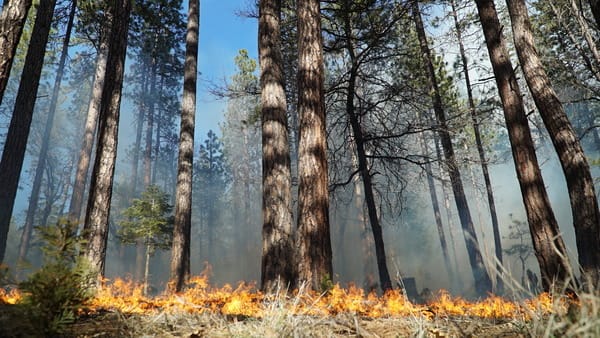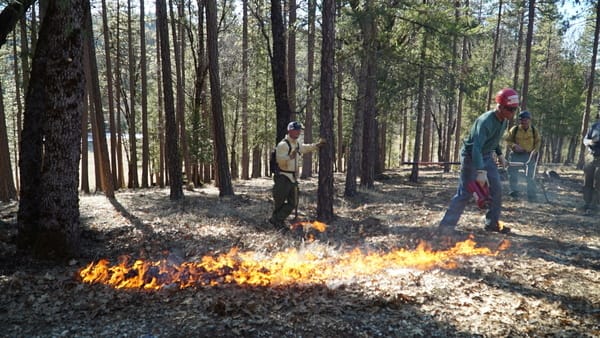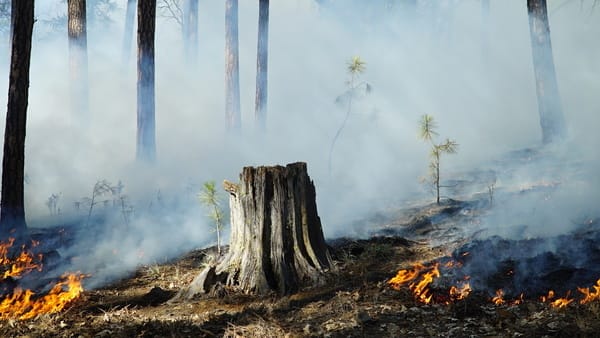- My World's on Fire
- Posts
- The window
The window
Thanks for reading My World’s on Fire, a weekly newsletter about disasters from journalist Colleen Hagerty. If you found this dispatch interesting, subscribe here for disaster deep-dives, Q&As, and context in your inbox every Thursday evening.
This is a crossover edition with Weathered, a seasonal newsletter about the built environment in the winter. I definitely recommend reading back through the archives and signing up to receive the final few editions before spring!
I wrote this essay after attending my first prescribed burn, which paid subscribers got a behind-the-scenes look at last week. I'm also considering a Demystifying Disasters post that would get more into the weeds about the process, so I'd love to hear your thoughts! You can always reach me by responding to this email.

After years of trying to avoid exactly this scene—bright flames swallowing his grass and seedlings, smoke plumes curling above the tops of his trees—Richard Batha’s front yard is on fire. He surveys it from behind sunglasses, taking a few steps back. Then, he starts pouring another line of flames from the drip torch in his hand.
It’s now widely recognized that there is no such thing as a wildfire season in California, as the potent mixture of climate change and years of fire suppression policies, among other ingredients, have made the state more susceptible to fires year-round. But this year’s hotter, drier winter has presented an opportunity in some areas for conducting prescribed burns—fires sent intentionally for land management purposes.
There has been a push in recent years to up the number of acres burned in the state during specific windows of the year, which can be rare. The conditions, like wind and humidity, have to be just so, and even then, it requires a concerted effort to get the necessary permits and approvals. I’ve previously written about how community members have been setting up groups known as prescribed burn associations across the state to do their part in conducting small-scale burns, often on private property. But this was my first time actually seeing one in real life.

Driving to Batha’s home in Quincy took me through the Plumas National Forest on an unseasonably warm February day. Along the curving road were reminders of why he decided to invite a few dozen strangers over for today’s event. Patches of burnt trees and scorched earth appeared off-and-on for miles, hinting at the devastation that wildfires have brought to the area in recent years. Last summer, Quincy became a refuge for residents fleeing the Dixie Fire, which fanned out north of the town; the summer before, the Northern Complex Fire burned just below it. Some locals express a feeling of inevitability, a recognition that they’ve largely been lucky so far and that they might not be next time, at least not without some drastic action.
There’s a small sign on the road ahead of Batha’s property to alert people to the burn, both so they won’t call the authorities out of concern and in hopes of piquing outside interest in their activity. While the main goal of the day is to eliminate some of the built-up dry leaves and other debris on the land that would fuel a wildfire, the secondary goal is to raise awareness in this wooded community of the value and benefit of prescribed burning.
By the time Batha lays the test fire on the land, the group has split off into assigned teams. There’s an assortment of expertise in the group of about 40 people—a number have spent years as firefighters or in the Forest Service, while others have dedicated their lives to studying it, trying to understand how California’s unique beauty is in part borne from burning. There’s a group of students from a nearby college, members of the Plumas Fire Safe Council, and volunteers with the Plumas Underburn Cooperative (PUC).
For some, this is something they’ve done many times before, and they’ve come prepared not only with the necessities but also some extras—two people carry speakers with them, providing a classic rock soundtrack to the afternoon. Others are clearly new, their hesitancy apparent in their small, careful steps. Still, from afar, it all looks choreographed, a series of figures in bright yellow gear zigzagging across their assigned acres.

The light wind drives the fire up the sloping property, carrying bits of advice through the smoke. Always have a way to tell time and lighter with you on burns, someone counsels. Try not to light any tree stumps, a member of PUC cautions—they ignite for much longer than the surface fuels and often require more of a “mop up” later with water. Full-grown trees are also purposefully avoided, leaves and debris raked away from them in an attempt to keep the flames from licking up to their branches.
The sun takes on a hazy glow as it starts sinking, beams of light illuminating the scorched soil. By the time it sets, nearly eight acres are complete. It went well; all according to plan, everyone agrees. Batha concedes that it was harder physical work than he expected, that the land is “not as pretty” as it once was, but that he’s happy to have done it. It’ll be interesting to see what happens next, he muses.

The conditions the day after a fire are important, too, and a smaller contingent returns to ensure there are no residual smoldering embers to address. It’s another warm day, and I wonder when we’ll stop thinking of this kind of weather in the winter as unusual.
Book club update
Last week was supposed to be the first meeting of the MWOF book club, but I decided to postpone given the developing situation in Ukraine and many of your requests. We'll now meet Thursday, March 24th at 8pm Eastern/5pm Pacific.
If you're already signed up, you'll get an email as it gets closer with details. If you'd like to take this opportunity to join, pick up a copy of Olga Dies Dreaming by Xochitl Gonzalez and sign up here.
As always...
thank you for reading and subscribing to My World’s on Fire.
If you value this newsletter, you can show support by becoming a paying subscriber for $5/month. Plus, you get some exclusive perks!
Or, if you’re not into commitment, you can buy me a coffee, the not-so-secret ingredient behind this newsletter.
It also means the world to me when you post about it on social media like Sarah Miller did:
Love that "When the feeds light up" by @colleenhagerty
featured @TheRedElm this week! newsletter.colleenhagerty.com/issues/when-th… via @Revue #SMEM#EMGTwitter— Sarah Miller is a #SEAKraken fan (@scba)
3:32 PM • Feb 11, 2022
Now, here’s a little something for reading to the end.
Colleen